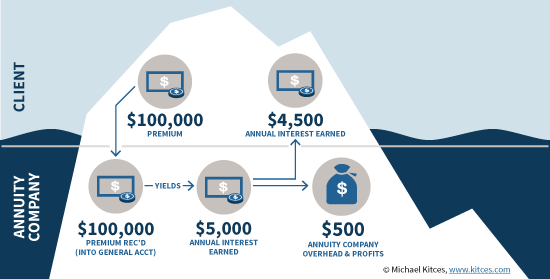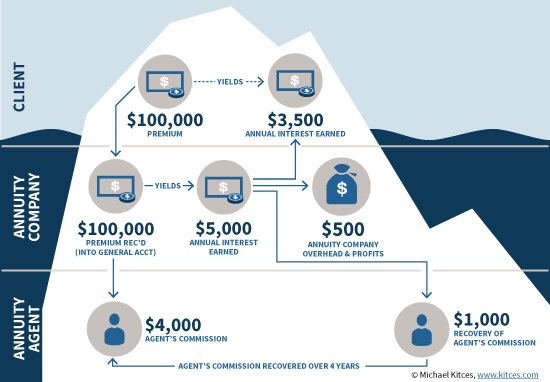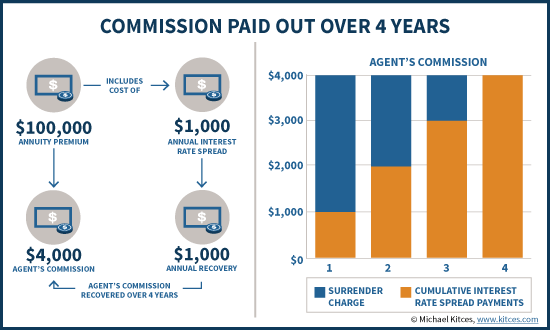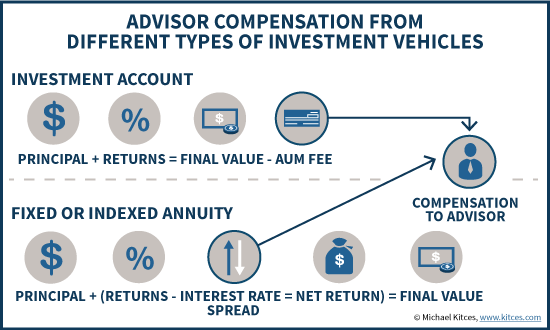Executive Summary
When investors hold investment accounts subject to an ongoing AUM fee, they can clearly see the expense being subtracted from the account on each statement. Similarly, variable annuities have an explicitly disclosed expense ratio that is subtracted from the account balance on an ongoing basis. However, in the case of fixed or equity-indexed annuities, investors only see their contributions into the account, and a return on the account, leading many to believe (and many insurance agents to claim) that such annuities are “free” or have no cost (and that any commissions paid to the agent are “paid by the insurance company, not the client”) and will not adversely impact their long-term retirement accumulations.
Yet the reality is that fixed annuities do still have an ongoing cost that reduces long-term returns; it’s just that instead of paying the expenses and compensation to the advisor directly out of the end value of the account each year, the costs are subtracted from the annuity company’s gross returns in the form of an interest rate spread before paying the net remaining return to the investor. Or in the case of the indexed annuity, the interest rate spread is subtracted before the remaining yield is invested into options to provide the investor’s participation rate in the index being tracked.
In fact, the whole purpose of surrender charges on annuities is simply to ensure that when an insurance agent is paid a commission upfront, the annuity funds will remain invested long enough with the ongoing interest rate spread extracted from the investor return to allow the insurance company to recover that commission cost from the investor (or else he/she pays a surrender charge to make up the difference!). In the end, this means that not only do fixed and indexed annuities have a cost to the client for compensation paid to the insurance agent that impacts long-term retirement wealth… but it’s actually remarkably similar to what investors typically pay brokers and investment advisers as well!
How Fixed Annuities Calculate Returns And Their Real (Interest Rate Spread) Cost
When a premium contribution is made to fixed annuity, the funds are normally invested by the insurance company as part of its General Account, which typically holds a wide range of bond investments, matched to the anticipated liabilities of the insurance company (e.g., to cover annuity claims, expected surrenders, and ongoing withdrawals/liquidations as they will come due).
To provide a yield to the fixed annuity holder, then, the insurance company uses the money in its General Account to generate an investment return on those invested assets, holds back a (usually small) portion for itself – an "interest rate spread" – and passes through the rest as the return. Thus, for instance, if the insurance company’s overall bond portfolio has a yield of 5%, the insurance company might pay 4.5% to the annuity holder, keeping the 0.5% difference - the interest rate spread - to cover its administrative/overhead expenses and to generate a profit margin for the insurance company.

The reason that interest rate spread matters is that while, from the annuity owner’s perspective, he/she will simply see “the fixed annuity paid a yield of 4.5% on 100% of the account balance", the reality beneath the surface is that the insurance company is extracting a 0.5% “AUM fee” from the return being generated by the annuity owner’s funds, in the form of an interest rate spread. This represents the true cost of a fixed annuity, although it can only be measured by determining what yield the investor "could have" had by purchasing bonds of similar credit quality on their own and seeing how much lower the annuity company’s payments turn out to be.
Notably, interest rate spread is also what is used to generate the funds necessary to pay – or technically, to recover over time – the commissions that are paid to an insurance agent who sells a fixed annuity. For instance, if the annuity pays a 4% commission to the insurance agent, the insurance company effectively “fronts” the 4% to the agent and then increases the interest rate spread by roughly 1%/year to recover the cost. Thus, if the insurer’s General Account is still yielding 5%, the insurance company might apply a 1.5% interest rate spread, of which 0.5% covers administrative/overhead and profit margins for the insurance company, 1% is the recovery of the agent’s commission, and the remaining 3.5% is paid to the annuity owner.

Again, in this example, the annuity owner will simply see that the fixed annuity pays a 3.5% yield on 100% of the account balance (e.g., "no upfront commission" paid), yet the reality is that ultimately 4% of the annuity contribution was in fact pulled aside and paid to the insurance agent, which the annuity company covers up front and then recovers over time by extracting a 1%/year recovery fee via the interest rate spread.
Notably, this is also the precise reason why annuity products typically have surrender charges – their purpose is to ensure that the annuity company can recover any remaining commissions that were already paid to the agent but haven’t been recovered via interest rate spread. Thus, for instance, an annuity that pays an agent a 4% commission might have a 4-year surrender charge, to ensure that the insurance company either recovers 1%/year for 4 years, or recovers the remainder in the form of a surrender charge instead. When the cumulative interest rate spread payments equal the agent's commission, the surrender charge goes away because the insurance company has recovered its insurance agent commission cost.

Equity Indexed Annuities Aren’t No-Cost Either!
In the case of equity-indexed annuities – another product often claimed to have “no costs” and “no expense for commissions paid to the insurance agent” – the reality is that the products operate in a substantively similar manner to fixed annuities, where insurance companies do collect an ongoing AUM-style fee in the form of an interest rate spread.
The only difference is that while with a fixed annuity, the yield from the assets in the General Account is paid out to the annuity owner (minus an interest rate spread), in the case of an indexed annuity the yield is used to purchased various combinations of options (e.g., a bull call spread) to provide the promised participation rate in the index. Still, in the case of an indexed annuity, the yield that is used to purchase the options is the remaining yield after subtracting an interest rate spread set aside for annuity company overhead and profits, and the recovery of the annuity agent's commission.

The fact that the index options are purchased using only the yield generated from the principal in the General Account is what provides indexed annuities with their principal guarantee; at worst, the options will expire worthless, and the principal will remain in place to provide a fresh yield again next year, which again can be used to purchase options to generate some participation rate in the index. Yet throughout the time period, the insurance company is still applying an annual “expense” in the form of an interest rate spread against the indexed annuity, which is used to cover overhead and profits of the annuity company and recover the commission paid to the insurance agent; likewise, indexed annuities also have surrender charges, again to ensure that the insurance company can collect the interest rate spread for enough years to fully recover the commission (or generate the remainder through the surrender charge itself).
Notably, in today’s low-interest-rate environment, by the time the funds are invested, and the interest rate spread is subtracted, there is not a lot left to actually invest into the index options, which would otherwise produce a participation rate so low that investors may not want to purchase the contracts at all. As a result, many of today’s indexed annuities actually do not guarantee 100% of principal, but instead only guarantee an amount like 90% of principal. By doing so, the annuity company can now use a portion of the remaining 10% of principal to purchase additional options every year, ultimately providing greater upside potential, at a “cost” of having less of a floor guarantee. (This is a normal trade-off for any options strategy, where a lower principal guarantee threshold amount to a greater upside participation rate.)
Comparing Fixed And Indexed Annuity Costs To Other (Annuity And Investment) AUM Fees And Expenses
Ultimately, the reality is that the expense of fixed and indexed annuities is actually remarkably similar to most other types of annuity and investment products provided by brokers and investment advisers, where the ongoing interest rate spread/expense ratio/AUM fee is used to provide compensation amounts to an advisor of about 1%/year. The only difference is that with a product like a variable annuity, the funds are held separately and the costs must be extracted with a specific “expense ratio” line item, as is true for the AUM fee from an investment advisory account as well; in the case of a General Account product like a fixed or indexed annuity, the cost is extracted as an “invisible” interest rate spread.
In either case, though, to the extent that compensation is paid to the insurance agent or broker or advisor, it ultimately comes out of the returns of the client, in a very similar manner, where the assets earn some gross return, that is reduced at some point along the way by the advisor's compensation, with the investor only keeping the net return.

In point of fact, these same principles of "no upfront commissions" combined with a higher ongoing fee to recover that commission, have also applied historically to mutual funds as well. In the early days, the A-share mutual fund extracted the commission paid to the advisor upfront, with only the net amount going into the investor's account; thus, if the investor deposited $100,000 but the commission was 4%, the account balance would read $96,000 after the deposit. Alternatively, the rise of the B-share, with its Contingent Deferred Sales Charge (CDSC), turned the previously-upfront-commission into one that was paid to the broker upfront but amortized by the mutual fund company over time through the expense ratio; the investor put in $100,000 to the account and saw an account balance of $100,000, but the expense ratio was 1% higher with a 4% surrender charge for 4 years, allowing the investment company to recover the upfront 4% commission at a rate of 1%/year over time. Of course, in the case of B-shares, the investor would normally (though not always) be converted to lower-cost A-shares once the surrender period had passed and the broker’s selling commission had been recovered; sadly, that may or may not be the case for any particular General Account fixed or indexed annuity product, as investors have little way to tell whether the insurance company begins to charge a lower interest rate spread after several years once the agent's commission has been recovered (given that interest rate spread costs cannot be seen in the first place!).
Similarly, interest rate spread is also the primary mechanic used to generate income for a bank (at least, as banking was traditionally done!); a bank that collects money in savings and checking accounts paying its customers 0.50% (in today's rate environment!), while it uses the money to lend out to third parties at 5%, is earning an interest rate spread of 5% - 0.5% = 4.5% (which, notably, is not quite as generous as it first seems when accounting for the fact that some loans will default). In point of fact, this is also the reason that the recent "free robo-advisor" launch from Charles Schwab includes a "mandatory" cash allocation that is swept to Schwab Bank; the interest rate spread generated on the cash position is the "fee" that Schwab will collect from investors, and to the extent the investor ends out putting more in cash, and/or earning a lower cash return than other higher-yielding-with-less-interest-rate-spread alternatives, that is a long term cost drag on a retirement portfolio not unlike the investor simply being charged an AUM fee in the first place!
The bottom line, though, is simply this: while paying an ongoing annuity expense through interest rate spread is less visible and harder to compare than a line-item expense ratio or AUM fee subtracted from the balance of a variable annuity or an investment account, in the end the cost structure that fixed and indexed annuities use to compensate insurance agents is remarkably similar to almost every other type of financial services investment product. While the agent’s compensation may be “paid by the insurance company”, it is still generated directly from and netted against the investment return produced by the client’s assets, as evidenced by the existence of surrender charges to ensure that the interest rate spread against the client’s assets remains in place for enough years to allow the insurance company to recover the commissions paid upfront. Which means in the end, it’s still a cost to the client for compensating the advisor, as is the case for any other insurance or investment product for which advisors are compensated! Of course, whether that's a "good" or "bad" cost depends on the value that the advisor provides, but it is a cost to the investor nonetheless!
So what do you think? Do you explain interest rate spread to annuity buyers as an 'investment' cost? Should annuity companies be required to disclose the detailed mechanics of their contracts so consumers can calculate the interest rate spread for themselves, or is the "net" yield all that matters anyway? Should annuity expenses be further incorporated into retirement projections for clients?





I’ve worked with many variable annuities over the years, and the M&E and rider charges are almost never disclosed on the statements.
Hey Michael..great article. I think it also brings up the importance of disclosure to clients when positioning these types of products. The “it doesn’t cost you a thing” is simply sales sizzle, and in my opinion, that type of selling only further exacerbates the issue of clients not understanding the value of solid advice. Perhaps you did mention it, but I think it’s worth repeating that good strategies don’t have to be “free” for them to be good moves for the client–no matter what type of investment or product is being recommended.
It isn’t sales sizzle. It is a lie! Many of these products are sold for the wrong reasons and under misrepresentations, deceit, and fabrications. Just listen to talk radio on the weekends when all the annuity guys cram the airwaves to sell free products.
In a year when equity markets are flat, a VA client will see fees erode their account value. Not so with EIAs, as “0” is the worst case scenario. I’d like to see your comments/comparison of Income Riders between VAs and EIAs. I understand VA riders, since the market could drop the account value significantly, and the rider will ensure income is paid. EIAs can’t suffer big losses, so why are people paying 40-75 basis points for riders that pay them back their own money over 20-25 years?
David,
See below from a related article Michael wrote that answers your question:
https://qa.kitces.com/blog/why-it-rarely-pays-to-wait-on-taking-withdrawals-from-a-variable-annuity-glwb-rider-a-case-study/
“Or viewed another way, it may be appealing to purchase a variable annuity for upside growth plus downside protection, but it’s not clear there will be any upside growth in a portfolio within a variable annuity with a GLWB rider dragging 3.1% in annuity costs (plus subaccount expense ratios), in a portfolio that must hold a 40% bond allocation in today’s low return environment. Simply put, the “just” 60% in equities can’t possibly generate a high enough return to overcome the bond drag, and the annuity cost drag, and still have more upside than just investing conservatively and taking withdrawals in the first place.”
This was written in July 2014 and the US market valuation has continued higher since then only strengthening the original point.
So if one is going to buy an income rider why not just the most generous income rider whether in VA form or otherwise.
Or even better in my opinion, just stay away from them altogether, do a good job constructing a plan for your client and educate your client that there are better ways to meet the plan cash flows than by buying the annuity.
Michael great article and this was on my lists of subjects to write on and never got around to it… I think your example of the insurance company only taking 0.5% is super generous (maybe TIAA CREF would do it for that cheap but unaware of anyone else, but they don’t do EIAs), I believe it’s more like 3-5% over the last 20yrs on average. Also, the GIO/Fixed accounts in variable annuities work the same way and have yielded investors ~3-4% the last 20yrs with the Barclay’s Agg at ~7.5%. Not that some of these products don’t have their place/value because they do, but clients deserve the right to understand what they’re buying and at what price. Thanks for another straight shooting article!
There are so many firms that are insurance/annuity only providers and hold themselves to the public as Financial Advisors. Wouldn’t it make more sense for regulators to go after these types of firms that offer “Free” services with “No Risk” and that are “Guarenteed”? Instead time is spent debating words like suitability and fiduciary that the average public could not define unless they a minor in English and a Law Degree.
Great article!
As a CFP, and fee-only advisor for many years, I was entirely against annuity products because of what I had read in various publications. However, as I dug deeper I discovered that fixed indexed annuities (FIA), the good ones (no roll-up for starters), can have a place in a portfolio.
Just because there is no free lunch doesn’t make them bad. Most people know that it is rare to get something for free. The true pros use a similar explanation as Michael has above.
And they should not be presented as a stock investment just because they are tied to a stock index. As Michael explained, fixed index annuities are mostly invested in high quality bonds, with a small portion in stock options.
Personally I position a FIA as an alternative investment, and it is only a part of a well balanced portfolio which includes stocks and bonds. I tell clients that while there are no guarantees, there is a reasonable possibility of FIAs (again, the good ones) returning somewhere in between stocks and bonds. To be fair, I explain there really is a bit of luck involved, especially if the “monthly sum” option is used.
I have a number of clients that added FIAs back in the fall of 2007. Yep, my timing was fortuitous, right before it the market hit the fan. And even when there was nothing to be made in 2008, so far the returns have yielded between 4-10% annually over the past eight years. I think a lot of alternative funds would be thrilled to have averaged that.
I would encourage CFPs and ChFPs to keep an open mind to annuities. Of course there are some terrible ones that only serve the agent, but there are also some good ones, albeit with interest rates so low they do not have the upside they once did.
the article is well explained and the illustrations in it have added more feel to it .
reduce overhead costs
I think one thing most are missing is that these are insurance products meant to be used as risk management tools and not investments per se. Most people buying these products are (or should be) buying them to help manage market and volatility risks. When the markets head south they don’t lose account value AND have to pay an aum fee because the good ones guarantee principal and previously credited interest. So in cases where the market loses 10% their $100,000 balance is still $100,000 rather than $100,000 – $10,000 (loss) – $1000 (aum fee) = $89,000. The protection of the insurance has prevented the loss. Many of my risk averse clients see some value there.